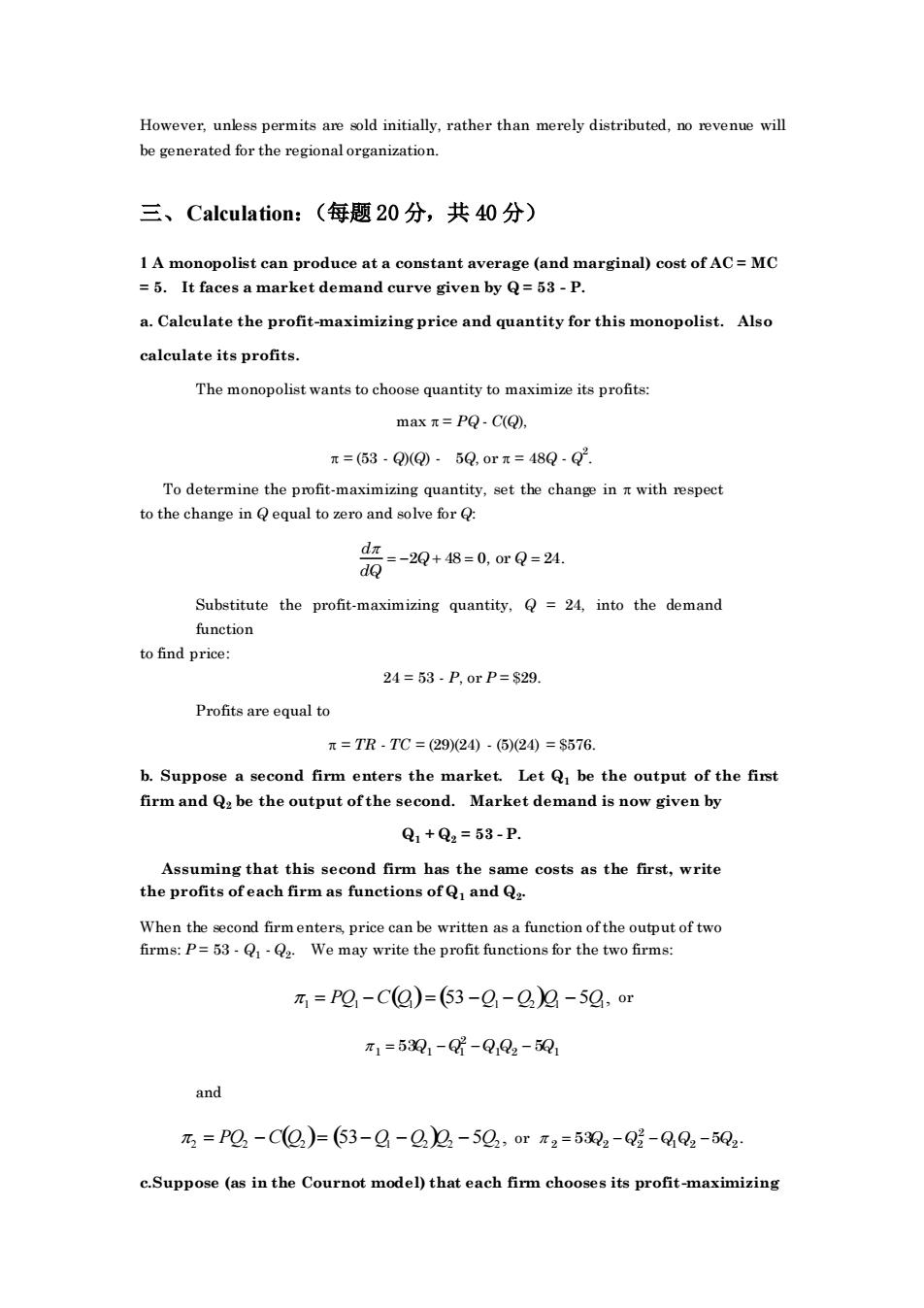正在加载图片...

However.unless permits are sold initially.rather than merely distributed.no revenue will be generated for the regional organization. 三、Calculation:(每题20分,共40分) 1A monopolist can produce at a constant average (and marginal)cost of AC=MC =5.It faces a market demand curve given by Q=53-P. a.Calculate the profit-maximizing price and quantity for this monopolist.Also calculate its profits. The monopolist wants to choose quantity to maximize its profits: max元=PQ.C(Q, 元=(63.Q5Q,orm=48Q.Q. To determine the profit-maximizing quantity,set the change in t with respect to the change in Qequal to zero and solve for Q: Substitute the profit-maximizing quantity,Q=24,into the demand function to find price: 24=53-P,orP=$29. Profits are equal to π=TR.TC=(29240.(6240=$576. b.Suppose a second firm enters the market.Let Q be the output of the first firm and Q,be the output ofthe second.Market demand is now given by Q1+Q2=53-卫. Assuming that this second firm has the same costs as the first,write the profits ofeach firm as functions ofQ and Q When the firms:P=53.Q-Q2.We may write the profit functions for the two firms: π1=P9-Cg)=53-0-g)2-5g,or 1=531-Q,2-5 and 乃=P22-C(g)=(53-9-Q2-50,orm2=53Q2-Q2-qQ2-5Q2 c.Suppose (as in the Cournot model)that each firm chooses its profit-maximizingHowever, unless permits are sold initially, rather than merely distributed, no revenue will be generated for the regional organization. 三、Calculation:(每题 20 分,共 40 分) 1 A monopolist can produce at a constant average (and marginal) cost of AC = MC = 5. It faces a market demand curve given by Q = 53 - P. a. Calculate the profit-maximizing price and quantity for this monopolist. Also calculate its profits. The monopolist wants to choose quantity to maximize its profits: max = PQ - C(Q), = (53 - Q)(Q) - 5Q, or = 48Q - Q 2 . To determine the profit-maximizing quantity, set the change in with respect to the change in Q equal to zero and solve for Q: d dQ Q Q = −2 + 48 = 0, or = 24. Substitute the profit-maximizing quantity, Q = 24, into the demand function to find price: 24 = 53 - P, or P = $29. Profits are equal to = TR - TC = (29)(24) - (5)(24) = $576. b. Suppose a second firm enters the market. Let Q1 be the output of the first firm and Q2 be the output of the second. Market demand is now given by Q1 + Q2 = 53 - P. Assuming that this second firm has the same costs as the first, write the profits of each firm as functions of Q1 and Q2 . When the second firm enters, price can be written as a function of the output of two firms: P = 53 - Q1 - Q2 . We may write the profit functions for the two firms: 1 = PQ1 −C Q1 ( )= 53 −Q1 − Q2 ( )Q1 − 5Q1 , or 1 1 1 2 1 2 1 = 53Q −Q −Q Q − 5Q and 2 = PQ2 −C Q2 ( )= 53− Q1 − Q2 ( )Q2 − 5Q2 , or 2 2 2 2 1 2 2 = 53Q −Q −Q Q −5Q . c.Suppose (as in the Cournot model) that each firm chooses its profit -maximizing